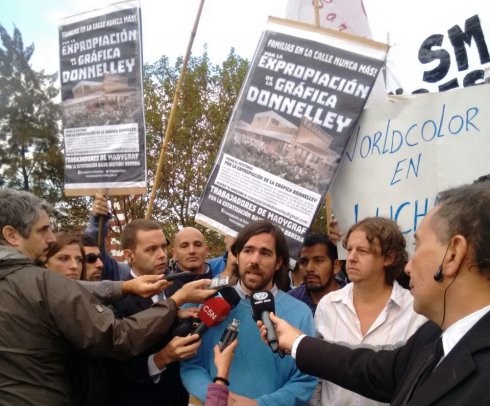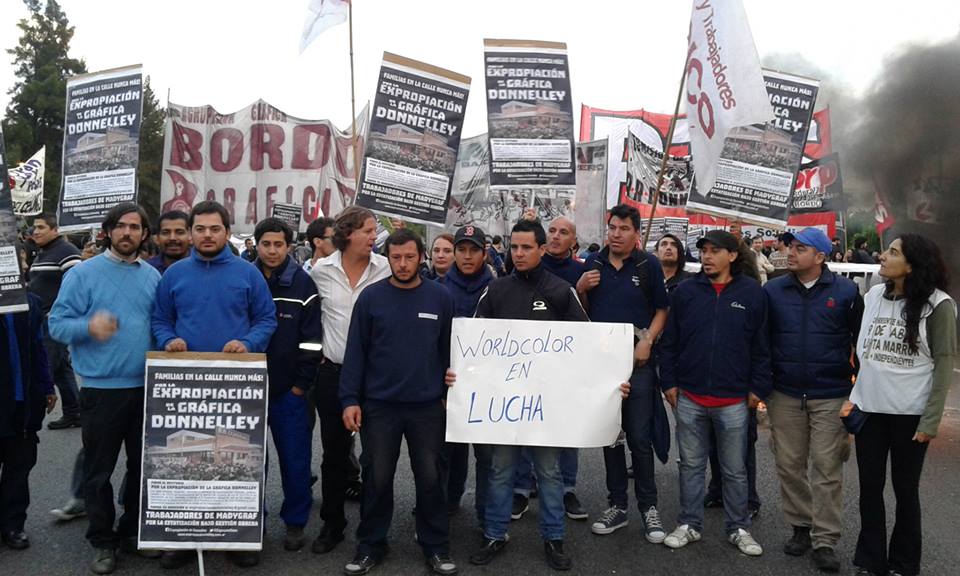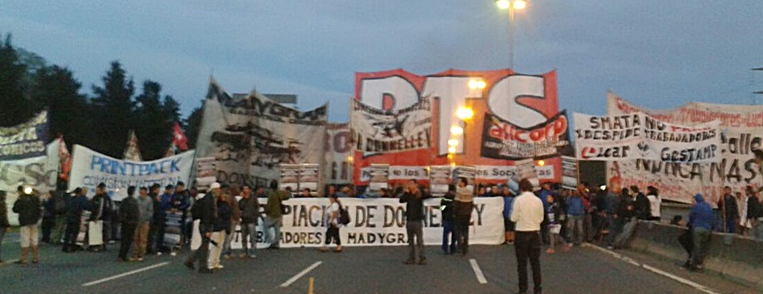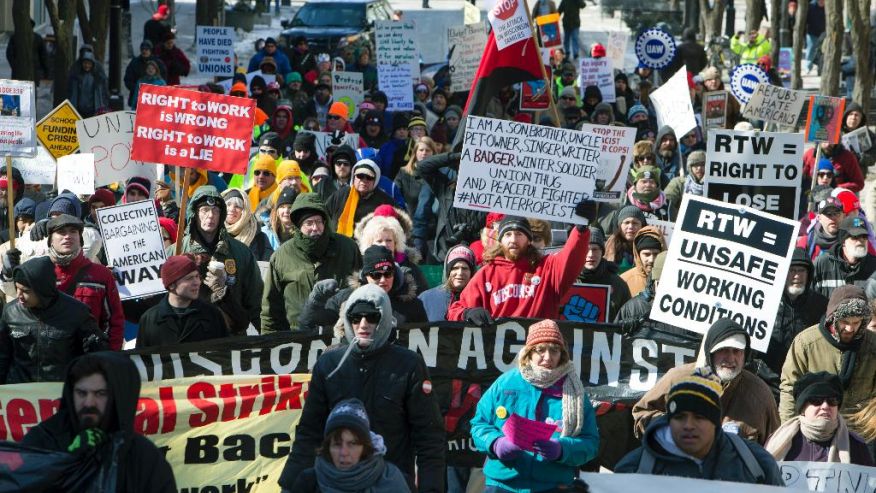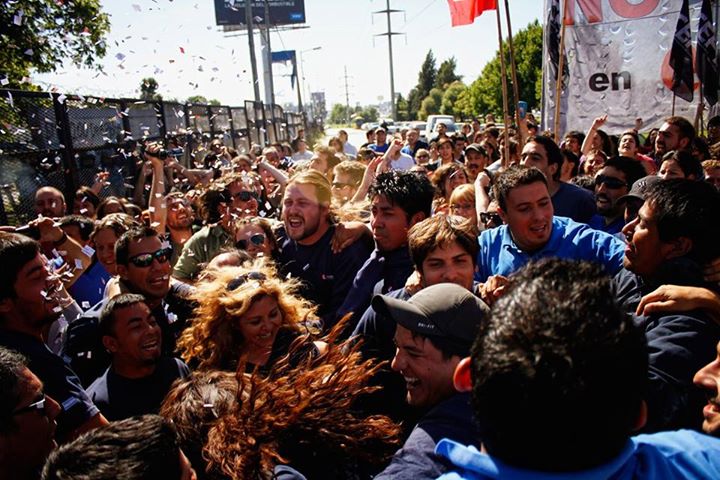A New Phenomenon in the Context of the Global Crisis
The industrial proletariat in France begins to stand up
14/06/2009
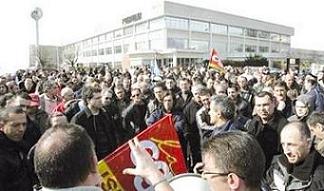
Written by a member of Fraccion Trotskista and the CLAIRE tendency within the NPA (*)
Waves of redundancies, underemployment, closing of businesses. The workers of France are feeling the effects of the global capitalist crisis, with 243,400 joining the ranks of the unemployed since August 2008, to which we must add 146,000 underemployed workers (statistic from the last quarter of 2008). Unemployment figures are expected to rise by 639,000 more this year; in other words 1,750 a day.
Faced by this social catastrophe which is only just beginning, private sector workers, above all those industrial workers who had been practically absent from the class struggle of the recent past, begin to respond. Their huge presence in the days of action of January 29 and March 19, and above all the wave of strikes and conflicts employing radical methods like the kidnapping of executives and bosses by factory workers, are testament to this.
Although with respect to the workers demands these conflicts are defensive, they represent an almost immediate response by the workers to the effects of the crisis in France, and an increasing radicalization of their methods of struggle. This first phase of workers resistance es more advanced in France than in any other part of the world and is an encouraging element in the face of the challenges workers will have to face in the coming months and years.
The bourgeoisie and the government are aware of this, which explains on the one hand certain concessions which have been granted to workers in some sectors despite the economic situation, and on the other hand the government’s hesitance about using tougher repressive measures. The collaboration of the trade union leaderships and their strategy of wearing out workers energy through isolated days of action, in the majority of cases without calling strikes, has been decisive in diverting these struggles away from a union which, allying itself to the struggles of the public sector workers and the youth, could lead to a general strike.
It is not coincedence that François Fillon, in a polemic with his predecessor Dominique de Villepin, said: “The trade unions are at times more responsible than some politicians who talk about our country as if it were in a pre-revolutionary situation.” It is precisely the dynamic towards the opening of such a situation which the trade union leaderships try (for the time being successfully) to block.
In this article we will try to trace, in general terms and with some examples, the characteristis of this first wave of strikes which has shaken the country and which announces a probable sharpening of the class struggle and awakening of the working class in the face of the global crisis.
A wave from the periphery to the centre (of production)
The automobile industry is a sector with one of the highest concentrations of workers of in France. If for now the bosses have managed to avoid large movements in the big producers, above all with financing by the state to encourage reduced hours over redundancies and thereby postpone a massive wave of firings, the car parts manufacturers, (who function as an adjustable variable of the automobile sector) have seen a great number of conflcits throughout the country. Examples of this are: Faurecia, Lear, Valeo, Treves, Visteon, Molex, Delphi, Akebono, Key Plastics, Preciplast, ThyssenKrupp Sofedit, Sonas, Wagon, IGAm Rieter, Eurostyle, Plastic Omnium, Simoldes, Inoplast and Sodimatex.
These conflicts, in many cases prolonged, have direct and important consequences for the production of the automobile manufacturers. The most notorious case is car parts manufacturer Lear in Lagny-le-Sec in l’Oise, where the strike, which has been going on for six weeks, led to the accumulation of 15,000 unsellable cars which have piled up at Peugeot-Citroën in Aulnay. However, other important regions have seen production practically paralyzed by the Visteon strike in Rougegoutte, after having been hit hard by the strike at the Key Plastics factory in Voujeaucourt. But the strikes in the car parts manufacturers do not only affect production at these companies. The strike at Faurecia in Aichel caused the one at Toyota in Onnaing, because it led to an increased reductions of shifs due to the lack of supply, cuasing considerable losses of wages for the Toyota workers. The workers there had also seen how those at Faurecia had obtained a forwarding of the 1,000 Euro bonuses from the companies profits and later compensation to the tune of 2,000 Euros, a demonstration of the effectiveness of the strike method. The contagious nature of these strikes did not stop there, some days later workers at the car parts manufacturer Sismoldès went on strike for the same demands as the workers at Toyota.
This process is also beginning to develop at the large producers like Peugeot-Citroën at Saint Ouen. In April the workers here, who had not been on strike since 1983, went on strike with 80% adherence against being told to work Saturday’s to compensate for days lost. After 14 hours of strike, the employees obtained the concession of one free Saturday per month, the raising of the bonuses paid for RTT1 days worked and payment for the hours spent on strike.
The strike at Toyota poses in embryonic form the question of who should pay for the crisis
A director General with a big mouth. This is what made the anger of the workers of Toyota at Onnaing explode at the beginning of April. When the boss said, with regards to unemployment: “it’s preferable to go bust than pay 100%” while the workers were going to lose 200-300 euros from their wages for April, it was the straw that broke the camel’s back.
At the beginning they were no more than 60, in a factory with 3,000 workers. But little by little the group grew: 4 days after the start of the conflict they were already 400, on strike to be paid for the days not worked at full production. This demand has the merit of posing the fundamental question of who pays for the crisis: bosses of workers?
A strike committee was formed and it decided to block the factory’s four entrances with pickets, causing production to cease completely. The result was the payment of the unworked days at 75% of the normal wage, including bonuses, which is to say 95% of the net salary, retroactive until February 1 and without the need to compensate for days lost.
Even though the strike could not force the payment of unworked days, but only their scaling for various month, the strike at Toyota showed that in the current situation even a strike by a minority, with tough methods, can force the bosses to retreat horrified by the threat of it spreading in a region very affected by social movements against layoffs and suspensions. In the same week, the government and the bosses, worried by the workers agitation, decided to implement a preventive increase of compensation for wages lost due to reduced hours for all workers.
Caterpillar: Signs of a bigger crisis between the workers and their representatives?
The Grenoble plant of the North American producer of machinery for the construction industry was a model of success, recognized as one of the most productive of the 174 which the group has in different countries. But during these last few months it was the negotiations over its downsizing plans reached an impasse, the radical actions of its workers and the conflict between these and the trade union leaderships which have given the factory its fame. The workers who had always worked so hard to ensure the company’s high levels of production and who had gone so far as to proudly say that if you cut them they would bleed yellow (the colour of the Caterpillar brand), did not take well to the announcement in January of a catastrophic downsizing plan which aimed at the redundancy of 5,000 employees globally and 773 at Grenoble. In addition, this announcement was made after years in which the plant worked at full production and enjoyed great growth which had led to the contracting of an additional 500 workers.
The conflict has its origins in this context. At the end of February, the workers created a strike committee which at the end of march decided to kidnap four directors and the company boss. In the middle of April, the official trade union representatives accepted an agreement with the bosses to reduce sackings from 773 to 600, in exchange for a reorganization of workers hours in which they should work longer night shifts in order to increase productivity. Around 200 employees at Grenoble and Echirolles, angered by the deal signed in Paris, interrupted the general assembly of the trade unions. The delegates who arrived in Paris after 9 hours of negotiation with the leadership, were not allowed by the workers to enter into the room where the general assembly was set to take place. “Now it’s us, the workers, who will decide, not the delegates”, declared an angry protester.
Then, the leaders tried to get the agreement passed calling for a referendum, but this was rejected by the majority of the workers. At the time of writing, all the trade unions except the CGT have signed the agreement, in opposition to the workers opinion and without questioning the sanctions against 19 workers, under the form of a “draft agreement” to be voted on in its definitive form in Octubre. During the assembly which took place later the secretary of the trade union committee at the company, a representative of FO (Force Ouvrière), had to flee in the face of workers outrage.
If the 600 firings end up being accepted it will evidently be an important defeat. But it will without a doubt be a lesson in the policitics of the trade union leaders.
Radical Methods, less so in the case of the program
Currently, the human resources administrators at the factories are providing a new service to the bosses: that of being able to respond to a kidnapping by workers.
This fact shows the generalization of this radical method, and some examples of this have been the cases of Sony, Molex, Caterpillar and 3M which at one point enjoyed the support of 45% of the population.
However, the workers who use these quite spectacular actions today, in the majority of cases, raise very defensive demands, like higher compensation for redundancy or the simple opening of negotations with the bosses, who are sometimes an ocean away. This is also a way of calling attention to frequently anonymous conflicts, buried under the wave of redundancies shaking the country.
In Continental at Clairoix, no bosses were kidnapped, but the boss was pelted with eggs the day he attempted to explain to an assembly of laid off workers the reasons for the closing of the establishment, which would leave more than 1,000 families in the street, after the workers had agreed only a few months before to work 40 hours a week, supposedly to save their jobs.
On the other hand, when those same workers - who were camped in the offices of the Federal Government in Compiègne waiting for the verdict on their demand of annulment of the announcement to close the plant at Clairoix - were made aware that their demand had been rejected, their accumulated anger exploded and they looted the sub-prefect‘s offices, before going to the factory and deciding to do the same.
After more than two months of struggle, the leadership of Continental has announced a concession which guarantees workers contracts (and therefore wages) until the end of 2011, an unemployment plan which guarantees 75% unemployment pay until 2014, as well as 50,000 Euros of compensation (net) with additional compensation according to length of time employed. This agreement, which should be signed in the week, represents a concession on the part of the bosses to break this emblematic struggle of a sector of the French working class, trying to paint the closing of the factory in bright colors and therefore avoiding an increase in political radicalization which could have been a spark for the subjectivity of the French and European working classes as a whole.
The “Contis”, as the workers of Continental are often called, have become a symbol of the tragedy which is affecting the whole of the French working class. If they had called for a unity of the existing struggles in a national fight against layoffs and to make the capitalists pay for the crisis, this could have represented a great step forward towards a break with the isolation of the struggle and its control by bureaucratic leaderships
This example shows the gap (which we talked about before) which exists between the radicalization of the methods of struggle and, for the time being, the lack of a radical political perspective which could permit the workers to overcome the existing situation which contains something of “every man for himself”.
In the same way, instead of taking these actions in order to obtain better compensation the workers had occupied the factories and put them to production themselves, demanding their expropriation without compensation under workers control, as the workers of Zanon have done, the situation would be totally different. For a factory like Continental to take this example would have stopped the bosses from breaking the strike with a financial concession - which although it improves the conditions, in the final analysis leaves more than 1,000 workers without work in a situation of serious crisis - and could have had a powerful effect as an example to the whole of the owrkers hit by the crisis, the massive redundancies and the closing of factories.
This is just the beginning…
Today, this movement of workers struggles which has spread across the country, together with that of the universities, the workers and the electricity companies EDF-GDF and the hospital workers, seems to be becoming diverted - in large part thanks to the collaborationist policies of the trade union leaderships - which pevents them from giving a qualitative leap forward and converging at a national level and posing the question of the general strike, which as we said at the beginning of this article, could open a pre-revolutionary situation.
But apart from the question of the outcome of this first wave of struggles, the fact that after years the industrial working class is coming out to struggle, in the context of an historic crisis of global capitalism which will bring even more firings and factory closures, could signal a new era for the class struggle in France and the world.
In this context, today more than ever if becomes fundamental for the NPA to intervene into the working class with perspective and program capable of transforming the anger into a political offensive against the whole capitalist class.
(*) The first version of this article was published in Boletín Au Claire de la Lutte N°2 (http://tendanceclaire.npa.free.fr/)
1 Reduction of Hours Worked, after the law which established a working week of 35 hours in France - in many companies instead of reducing the working week, free days were introduced which when worked would be paid at overtime rates.
